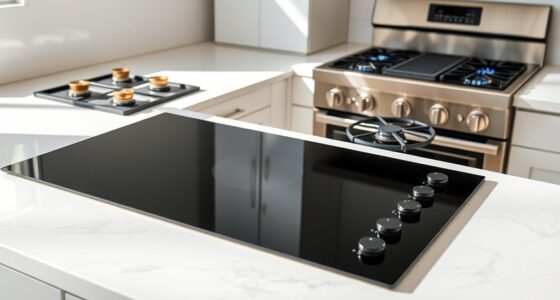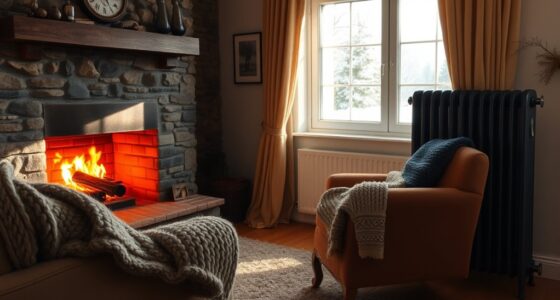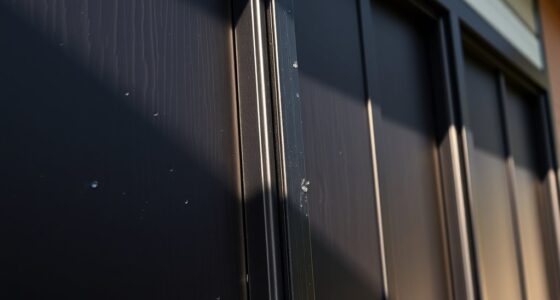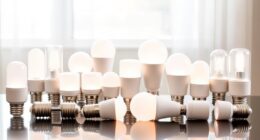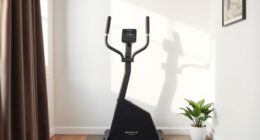Modern low-flow fixtures are designed to perform just like traditional ones, so you won’t notice any difference in water pressure or comfort. Advanced aerators and pressure-compensating valves create full, robust streams while saving water. These fixtures are engineered to feel seamless and satisfying, delivering the same user experience without wasting gallons. If you want to discover how to enjoy eco-friendly fixtures that feel just right, keep exploring what’s available today.
Key Takeaways
- Modern low-flow fixtures use aerators and pressure-compensating valves to deliver full, robust streams that feel similar to traditional fixtures.
- Adjustable flow restrictors allow users to customize water flow for optimal comfort without sacrificing efficiency.
- Innovative designs maintain consistent water pressure, ensuring tasks like rinsing and washing feel unaffected by flow reduction.
- Advanced bowl and siphoning mechanisms in low-flow toilets ensure effective flushing, mimicking the performance of standard models.
- High-quality materials and engineering create low-flow showers and faucets that provide satisfying, invigorating experiences without feeling restrictive.

Low-flow fixtures are designed to reduce water usage without sacrificing performance, making them an eco-friendly choice for homes and businesses. You might worry that cutting back on water means sacrificing comfort or convenience, but today’s low-flow fixtures prove otherwise. Modern technology has advanced to guarantee you don’t feel like you’re settling for less. Whether you’re taking a shower, washing your hands, or flushing a toilet, these fixtures deliver a satisfying experience without wasting gallons of water.
Low-flow fixtures deliver the same comfort and performance while saving water and protecting the environment.
When you step into a shower fitted with a low-flow showerhead, you might expect a weaker spray, but that’s rarely the case anymore. These fixtures are engineered with aerators or pressure-compensating valves that mix air with water, creating a full, robust spray. The sensation is just as invigorating as a traditional shower, only you use considerably less water. You won’t notice any difference in water pressure, but you’ll appreciate the reduced water bill and the positive environmental impact. This technology keeps your shower feeling powerful without the usual water wastage.
Similarly, low-flow faucets for sinks and kitchen counters incorporate innovative designs that maintain strong, steady streams. They often feature adjustable flow restrictors, so you can customize the water flow to your preference. This means you get the same useful water pressure for tasks like rinsing dishes or washing your face, but with less water flowing through the tap. The experience remains seamless; you won’t feel like you’re struggling to get enough water. Instead, you’ll enjoy efficient use without compromising performance.
Toilets have also seen remarkable improvements. Modern low-flow models use fewer gallons per flush but are engineered to clear waste effectively every time. They use innovative bowl designs and powerful siphoning mechanisms to ensure a thorough flush, so you don’t have to flush twice or worry about clogs. The result is a toilet that saves water and still provides the same reliability you expect from traditional models. You’ll appreciate how these toilets work quietly and efficiently, reducing your overall water consumption without any noticeable difference in performance.
In all these cases, the goal is to deliver the same user experience you’re accustomed to, but with smarter water management. You won’t feel like you’re sacrificing comfort or efficiency—you’re simply using water more wisely. Low-flow fixtures have come a long way, and today’s models are engineered to feel just like traditional fixtures, only better for the environment. They’re a smart choice for anyone looking to cut costs and reduce their ecological footprint without compromising on everyday convenience.
Passive voice detection tools can help ensure your writing remains clear and engaging by highlighting areas where active voice can be used for improved readability.
Frequently Asked Questions
How Do Low-Flow Fixtures Save Water Without Sacrificing Performance?
Low-flow fixtures save water by using advanced aerators and efficient valve designs that reduce flow rates without compromising pressure. You’ll notice good performance because these fixtures optimize water flow, maintaining strong pressure while using less. They’re engineered to deliver a satisfying user experience, ensuring you don’t feel like you’re sacrificing performance while conserving water. By upgrading, you help reduce your water bills and environmental impact without sacrificing comfort.
Are Low-Flow Fixtures Suitable for Commercial or Industrial Use?
Yes, low-flow fixtures are suitable for commercial and industrial use. They help you conserve water and reduce utility costs without sacrificing performance or user experience. Modern low-flow fixtures are designed to handle high demand and heavy usage, making them reliable for busy settings like restaurants, offices, and factories. You can implement them confidently, knowing they’ll meet your sustainability goals while maintaining efficiency and comfort for your customers and staff.
What Maintenance Is Required for Low-Flow Fixtures Over Time?
You should regularly clean and inspect your low-flow fixtures to prevent buildup and guarantee ideal performance. Check for leaks, and replace worn-out washers or seals promptly. It’s also helpful to flush the system occasionally to clear out mineral deposits or debris. By staying proactive with maintenance, you’ll keep your fixtures functioning efficiently, saving water and reducing long-term repair costs. Regular upkeep guarantees they continue to perform well over time.
Do Low-Flow Fixtures Comply With Current Water Efficiency Standards?
You’re on the right track, as low-flow fixtures generally meet current water efficiency standards. They’re designed to preserve water without sacrificing performance, so you won’t have to compromise on comfort. However, it’s wise to verify the specific models’ certifications, like WaterSense labels, to guarantee compliance. Keep in mind that technology is always evolving, so staying updated guarantees you’re doing your part in water conservation efforts.
Can Low-Flow Fixtures Be Retrofitted Into Existing Plumbing Systems?
Yes, you can retrofit low-flow fixtures into existing plumbing systems. You’ll need to select compatible models and possibly make some adjustments to your current setup. It’s best to consult a professional plumber to guarantee proper installation and avoid leaks or pressure issues. Retrofitting is a smart way to conserve water without sacrificing performance, and it can often be done without major renovations or expensive replacements.
Conclusion
Remember, sometimes the best things come in small packages. Low-flow fixtures prove you don’t have to sacrifice comfort or style to save water. With the right choice, you can enjoy a satisfying shower or a powerful sink flow without feeling like you’re missing out. So, don’t judge a fixture by its size—give it a try and see how it can make a big difference in your home and the environment. After all, every drop counts.


